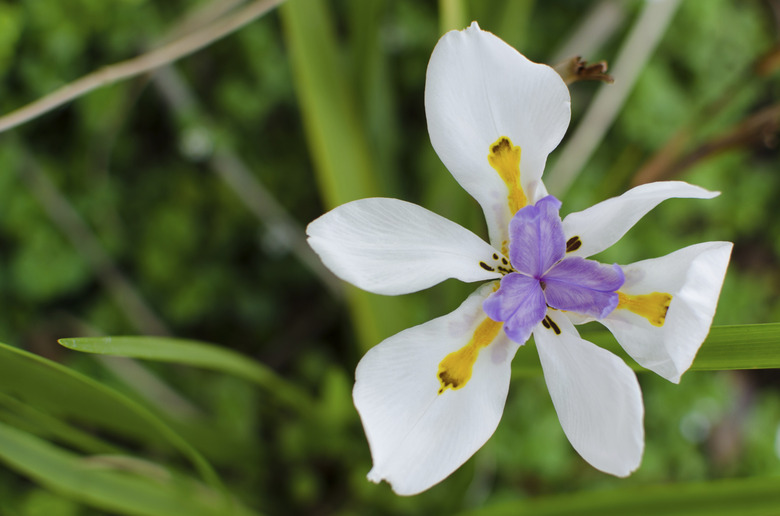How To Care For An African Iris
Things Needed
- Fertilizer
- Bucket
- Household bleach
- Isopropyl alcohol
- Pruning shears
- Garden spade
- Hand cultivator
- Sharp knife
The African iris (Dietes iridioides) is hardy in U.S. Department of Agriculture plant hardiness zones 8b through 11, where it can be planted and grown year-round and is known for its striking characteristics. Beyond the familiar long spiked leaves, the flowers open into a configuration that is the inspiration for one of its other names — the butterfly iris. Its compound white blossoms consist of five or six lower slightly curled drooping petals beneath a second set of petals of a contrasting color that emerges in a vertical position from the center. The African iris can be grown from seed but is more commonly propagated from rhizomes, which are large fibrous sections of roots that can be divided every few years in the spring.
Step 1
Provide sufficient water for the African iris until it is fully established, which can take up to a year. After that time, water occasionally when the soil appears dry. Water new plants daily for two or three weeks. Water the soil at the base of the plants down to about 8 inches and test the soil for moisture with your finger.
Step 2
Fertilize established African irises in early spring and again in mid summer. Use 1 to 2 tablespoons of a 5-10-10 or 5-10-5 fertilizer and sprinkle it on top of the soil at the base of the plants but not touching the rhizomes to avoid burning the roots. Water the fertilizer into the soil immediately after applying. Don't use fresh manure, as it can cause rhizome rot.
Step 3
Perform spring maintenance that includes removing any brown leaves affected by cold winter temperatures. Prune the plants regularly during the growing season to remove spent flower stalks and withered leaves. Sterilize the pruning shears by dipping their cutting blades into a solution of 2 tablespoons household bleach and 1 gallon of water for 30 minutes or by wiping the blades with isopropyl alcohol.
Step 4
Keep the area around the irises weed-free by carefully pulling up unwanted plants, or by lightly cultivating around and between the plants, being careful not to dig deeply, which could damage the rhizomes. Mulch the area between and along the sides of the plants with shredded bark, straw or aged compost to keep weeds down.
Step 5
Divide the irises in spring or fall after two or three years or any time the plants appear congested and crowded. Remove all but the lower third of the plant with pruning shears that have been sterilized and dig the plant up carefully. Wash off most of the soil and — using a sterile knife — cut off the older and damaged sections, keeping only the outer rhizomes.
Step 6
Cut the rhizomes into sections that have one or two leaf fans and white roots. Replant the new roots in rich well-drained soil in a sunny to partially shaded location or give them away to other gardeners.
Tip
According to the University of Nebraska-Lincoln, the plants can be troubled by iris borers which cause symptoms such as dark streaks and ragged edges on new leaves. The Missouri Botanical Garden recommends preventive measures that include removing the previous year's dead growth down to the rhizomes before April. For serious infestations, spray the new leaves in spring with a solution of 2 tablespoons neem fungicidal oil and 1 gallon of water. Repeat applications every 7 to 14 days to prevent borers from entering the plant's leaves. Apply in the early morning or early evening when conditions are not hot. African iris is useful in borders along pathways or driveways and as a taller accent plant among lower plants or ground covers. It can also be grown as part of a water feature such as near a fish pond or other wet areas where it can grow to 5 feet.
